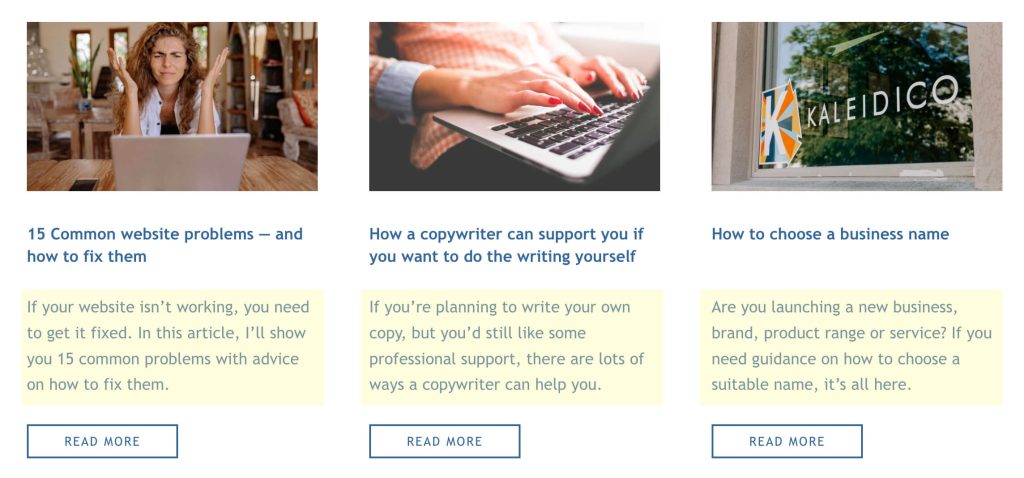If you’re considering signing up for one of my content packages, you might be wondering what’s included and whether it covers everything you need.
In this article, I’m going to go through what you’ll get in your content plan, which is a feature of my Write it Yourself and Done for You SEO content packages.
What is a content plan?
The content plan is where all the pieces of your content package fit together.
It includes your:
- Content strategy
- Article ideas
- Article outlines (if you’re writing the articles yourself)
- Posting schedule.
The plan is what we’ll be working to when we create and publish your blog content.
Your content strategy
We’ll start the process by creating your content strategy. This is a fundamental first step, because your content strategy will shape every piece of content in your plan.
Let’s have a look at what will go into your content strategy and what we’ll be working towards.
Your aims and objectives
We’ll start your project by having a strategy call. During this call, we’ll discuss the aims and objectives for your content and what you want it to achieve for your business.

There are all kinds of ways your blog can support your business, from educating your prospects and saving you time, to generating leads and converting new customers.
To give you some inspiration, here are some examples of what content could do for your business:
- Explain how a product or process works so prospects know what to expect
- Reach more of your market and attract them to your website
- Demonstrate your expertise, giving people confidence to work with/buy from you
- Provide troubleshooting guidance to existing customers
- Convert more visitors into email subscribers and customers
- Answer some of your FAQs.
Your target audiences
Next, we’ll take a look at the kinds of people you want your blog content to target.

Your website copy will be written to target people who are almost ready to buy. But there are lots of other people you could be talking to who aren’t at that stage yet.
For example:
- Problem aware people — who are researching a problem they have
- Solution aware people — who are looking for a solution to their problem
- Product aware people — who want to know if what you’re offering is right for them
- Existing customers — who’ve already bought from you and may do again.
Based on the aims and objectives you’ve set out, I’ll identify these people and the content you could be creating for them. This will help you attract them to your website where you can nurture them with the information they need to become customers.
Your content pillars
Your content pillars are the main themes and topics for the articles on your blog. They can also be used as categories to keep similar articles together and improve the user experience (UX).

The kind of content you’ll be posting will depend on your aims and objectives and the target audiences you want to reach.
In this section of the plan, I’ll put forward the content pillars I think we should use on the blog, with a brief description of each one.
The research
The research portion of your content plan is done behind the scenes, so it won’t appear in your document, but it will inform everything that does.
Audience research
I’ll start by researching your different target audiences to find out:
- The searches they’re doing on Google
- The questions they want answers to
- Alternative solutions to their problems
- What they value most.
I’ll then tailor your content suggestions to meet their needs and give them what they want to see.
Subject research
I’ll research the subjects we’re going to cover thoroughly, using current, credible and original sources. I’ll decide what information is relevant and necessary for your audience and use that to plan out each article.
SEO Keyword research
Some of the SEO keyword ideas will come from the audience research and some from the subject research. They’ll be split into three categories: primary keywords, secondary keywords and semantic keywords.
Primary keywords
Primary keywords are the main keywords we want to target in the article and the ones we want to rank for.
Secondary keywords
Secondary keywords are keywords that are closely related to the primary keywords. They could be variations on the primary keyword or longer tail versions of it.
Semantic keywords
Semantic keywords are the accompanying words we’re going to use in the article to help give meaning and context. For example, if it’s an article about windows, we might include semantic keywords like glass, glazing, sill, frame and curtains.
Ranking competitor research
When I’m researching the SEO keywords and deciding on the best ones to use, I’ll be looking at the competitors who are already ranking for those keywords.
I use Google’s top three as my benchmark and assess how those articles have been put together and what we’d need to do to rank among them.
DISCLAIMER: there’s no guarantee that I’ll be able to get your article ranking in the top three, but you might as well aim high, right?
Your content ideas
Each content idea will be laid out for you with all the elements.
Article title
I’ll give you the proposed title for your article. This will contain your primary keyword and will give your target audience a compelling reason to click on it.
Article rationale
I’ll outline how this article fits into your strategy and what I expect it will do for your business.
Target audience
I’ll tell you which of your audiences we’re targeting and explain how the article will meet their needs.
SEO keywords
I’ll take you through the primary, secondary and semantic keywords we’ll be using in the article.
Article categories and tags
I’ll explain the categories and tags that should be assigned to the article.
Custom meta description and excerpt
The article meta description is a short overview of the article and what it’s about. To make sure it displays in full on all devices, it needs to be a maximum of 155 characters, including spaces.
The meta description can contain keywords, but its main purpose is to entice users to click on your article link.
The description displays on the search engine results page (SERP). You can see it in the example below, it’s the two lines of black text underneath the blue page title.

I always write a custom meta description, but there’s no guarantee Google will use it as it often displays a random piece of text from within the article.
The custom meta description can double as an excerpt for your main blog page — if your blog page includes excerpts.
In the example below, the excerpts from my own articles are highlighted in yellow.

Your article outline
Article outlines are exclusively for clients who subscribe for my Write it Yourself package.
The outline is designed to make the writing process easier, by giving you an SEO framework to follow.
Your article outline will comprise:
- Search-engine-optimised (SEO) title
- SEO main headings and subheadings
- SEO keywords to include in each section
- A suitable call to action (CTA) at the end.
With the SEO side taken care of, you can focus on the writing and adding your brand personality.
And when the article is finished, I’ll give it a final once-over to make sure it’s ready for you to publish.
Your posting schedule
When you’re blogging for your business, consistency is important.
Your posting schedule will give dates for:
- Completing and submitting the first draft
- First draft amends/approval
- Publishing to your blog.
Having these dates keeps us accountable and ensures we stay on target.
Is my content service right for you?
If you need help with planning and SEO-optimising your content, I offer a choice of two different content packages. Both of these packages include the content plan I’ve described in this article.
Here’s a quick rundown of each one.
Write it Yourself
This option is for you if you’re a decent writer and you want to write your own blog articles. But you need some help with content planning, article ideas, SEO keywords and accountability.
This package also includes some mentoring with article feedback and pointers.
Done for You
This option is for you if you don’t have the time or inclination to blog and you want to fully outsource it to an expert. This includes everything, from content planning and article ideas, to researching, writing and SEO-optimising the articles for the web.
You’ll find full details of each package on the Content Writing page of my website.

You might also like…



